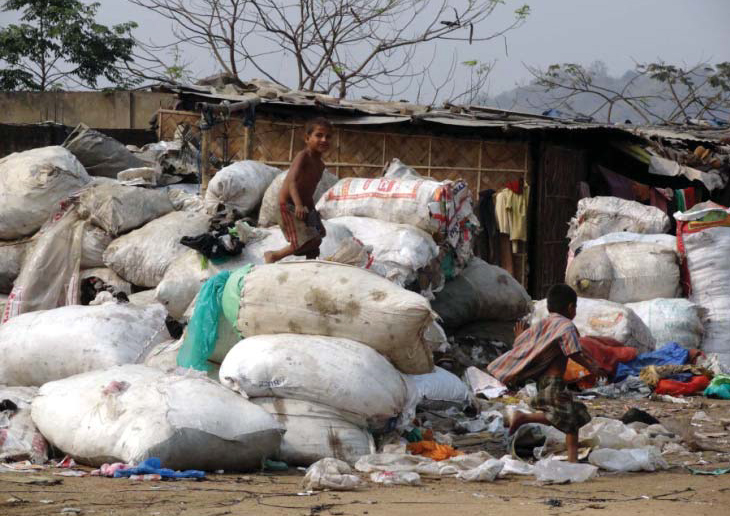
Urban cities are at the forefront of climate change induced impacts. Rapid urbanisation has exacerbated climate risks, created new ones and heightened human vulnerabilities, particularly those of children, to these risks. Can these vulnerabilities be addressed to make a city more resilient? Will governance measures help the most vulnerable population, especially the children?
Better urban governance seems to be an obvious step in this direction.
But, the question is whether the governing body is aware of these climate risks? And even if it is, does it have sufficient funds to deal with it? And what of any accountability mechanisms in place to implement the meaningful and pro-poor climate adaptation programmes that it decides?
A study 'Urban Governance and Urban Climate Change Resilience' conducted across 5 Indian cities: Shimla, Indore, Gorakhpur, Panjim & Guwahati ; investigated just this. It assessed these cities experiences of dealing with climate change within their governance framework and concluded that that integrating climate change aspects into city development plans is influenced by various factors.
The report further came up with recommendations that can help in building children’s resilience to climate change in the urban settings. These are:
1. Recognition & mainstreaming
- Need to be recognized and mainstream children’s issues
- Understand children’s disaggregated vulnerabilities
- Plan specific action to address these
2. Participation
- Crucial to address children’s participation in basic issues
- Ensure involvement at ward, zone and city levels of planning system
- Link priorities and suggest actions at local level with resource allocation
3. Accountable & transparent
- Reduce gap between service providers and end-users of those services
- Increase accountability of city officials towards its citizens
- Ensure quick and real time response to problems by the government
4. Vertical & horizontal coordination
- Ensure effective coordination to the vertical and horizontal dimensions of governance
- See intra-institutional, inter-sectoral and urban-peri-urban/rural coordination in a holistic manner
5. Ecosystem base resilience:
- Encourage healthy, well-functioning ecosystems to reduce vulnerability of people, especially children.
- Strengthen city systems
- Encourage those which use biodiversity and ecosystem services
- Include conservation of waterbodies, increase fl ood buffering capacity of cities, conservation of open and green spaces, groundwater recharging mechanisms, inhibit contamination of groundwater, maintain close link between peri-urban and urban areas
6. Governance issues
- Avoid duplication and fragmentation of roles between different institutions
- Encourage coherent action among policy makers, regulators and implementers and other stakeholders
- Formulate policies so that parastatal agencies operate under the guidance of the Municipal Corporations
7. Enforcement of rules & laws :
- Work towards strict enforcement of rules and laws pertaining to increasing encroachment, illegal construction on green and open areas, informal settlements in river basin and low lying fragile areas, etc.
- Adopt resilient practices like rainwater harvesting systems
- Implement attractive schemes which will work as motivation for the citizens to adopt such practices
- Institutionalize close collaboration of Development Authorities (Planning) and Municipalities (Execution) is urgently needed to be institutionalized
- Evolve the Master Plan with people’s participation and make it a public document for easy access by all
8. Equitable and inclusive :
- Facilitate coordination of informal institutions present in the
- Encourage ownership of resources, ecosystems and services by the urban citizens
9. Delineation of wards
- Should be on a geophysical basis rather than on an administrative
10. School curriculum:
- To include functional knowledge on urban climate change resilience and awareness on ecosystems around them
11. Temporary schools:
- Provision of temporary schools in the unnerved areas
12. Third party impact:
- Zone as a unit (made on geo physical) should be considered for planning
13. Ward autonomy and physical allocation:
- Bring governance at door step of people through decentralization
- Cater for Ward Corporators’ offices at Ward level itself
- Strengthen Area Sabhas and Ward Committees
- Format ward committees on a ward basis rather on a cluster basis.
- Link neighborhood level, ward level, zonal level and city level resources
14. Use of science and technology in enhancing governance:
- Use of technology should be adopted at planning, designing and monitoring levels for any development intervention
Of course, any action on these conclusions can only be achieved with adequate financing for which budgets need to be allocated and spent in a timely manner.
This is the fifth and last blog based on the study ‘Urban Governance and Urban Climate Change Resilience ‘ by Gorakhpur Environmental Action Group, supported by UNICEF, New Delhi.
Blog 4: Vulnerable children: A climate change challenge
Blog 3: Making children climate resilient: These cities show the way
Blog 2: Climate change, children & their education
Blog 1: Missing ‘children’ in the climate change dialogue